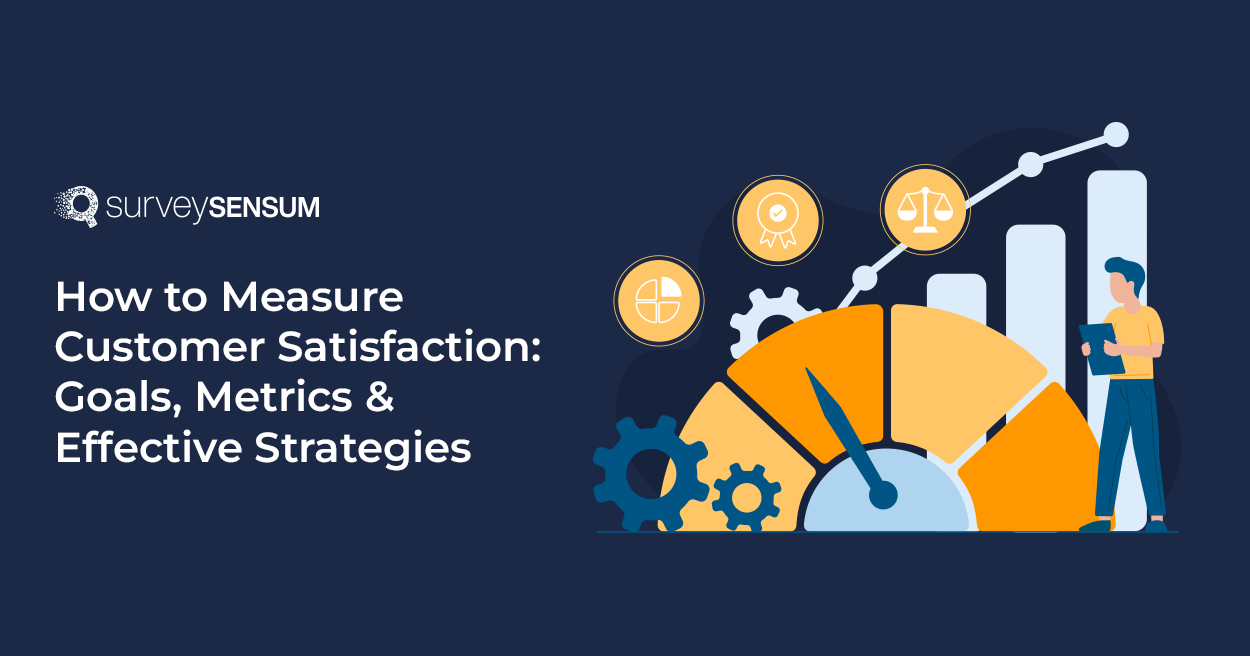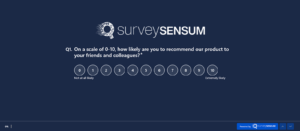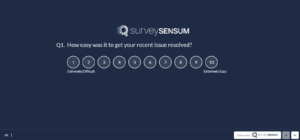9 Ways to Improve NPS Response Rates
Read More

Paul’s online handcrafted jewelry store started seeing a decline in customer satisfaction and repeat purchases.
So he started sending CSAT surveys after every purchase to his customers to learn about their shopping experience, product quality, and overall satisfaction.
And the customer satisfaction software helped him automate the process!
The survey revealed that
Armed with this feedback, he made improvements to his website’s user interface, optimized the shipping process to speed up delivery, and also fixed the website’s checkout page. This led to happier customers, more positive reviews, and increased repeat purchases.
But wait.
Don’t you think customer satisfaction is about more than just fixing customers’ issues?
Well, it is.
In simple terms, customer satisfaction isn’t just about solving issues. It’s about making customers so happy that they stay and bringing in new customers.
And this is what this comprehensive blog uncovers including the various aspects of customer satisfaction, how to measure customer satisfaction, and the strategies that can help you exceed customer expectations.
But why is it crucial to measure the satisfaction of customers?
You should measure customer satisfaction to understand how satisfied or happy your customers are with your product, service, or overall brand.
There are many more reasons to do it –
Now that you know the reasons for measuring customer satisfaction. Let’s explore the metrics to measure customer satisfaction effectively.
Now, let’s dive into the essential metrics that help you gauge and enhance customer satisfaction.
This metric captures how happy your customers are overall.
You ask them a straightforward question like, “How satisfied are you with our product or service?” The answer tells you about their overall satisfaction and experience.
Customer satisfaction is closely tied to their perception of your product or service’s quality. You can gauge this quality in a few ways:
Satisfaction isn’t just about avoiding regrets; it’s about making customers feel they made the right choice. By understanding the link between quality and satisfaction, you can measure and improve customer happiness.
Launch Customer Satisfaction Survey – Sign Up for Free
This metric digs deeper to evaluate various aspects of your product or service. Instead of asking for overall satisfaction, you inquire about specific attributes.
→ For example, if you run a restaurant, you might ask about your restaurant menu, food quality, service speed, or cleanliness. You can ask a question like
By focusing on individual aspects, you get a more detailed view of what’s working and what needs improvement. It helps identify areas where customers are highly satisfied and pinpoint those that may require attention.
This metric is a crucial indicator of long-term success. It measures the likelihood of customers continuing to do business with you and recommending your products or services to others. You can measure customer loyalty by asking NPS questions like:
High scores on these questions are indicative of strong customer loyalty. When customers are loyal, they not only come back for repeat business but can also become brand advocates, bringing in new customers through positive word-of-mouth.
Customer loyalty helps in establishing a solid customer base, increasing customer lifetime value, and reducing customer acquisition costs. It’s a key metric to track for building a sustainable and profitable business.
Repurchase intentions gauge the likelihood of customers returning to make additional purchases. This metric provides insights into customer behavior beyond the initial purchase. You can measure repurchase intentions with questions like:
High scores indicate a strong likelihood of customers returning for more business. These repeat customers not only boost your revenue but also contribute to higher customer lifetime value.
A high repurchase intention suggests that your product or service has met or exceeded customers’ expectations, leaving them satisfied and eager to continue doing business with your brand. Also, it’s easier and more cost-effective to sell to existing customers than to acquire new ones, making this metric a valuable indicator of business growth and success.
Now, let’s look at the 5 KPIs to measure the satisfaction of the customers.
To truly understand customer satisfaction, businesses rely on KPIs. These KPIs help measure various aspects of customer happiness and provide actionable insights. Here are five essential ones.
 Net Promoter Score measures the likelihood of customers recommending your product or service by asking a simple question
Net Promoter Score measures the likelihood of customers recommending your product or service by asking a simple question
→ On a scale of 0-10, how likely are you to recommend us to a friend?
The scale is divided into three parts; high scores (9-10) are promoters, (7-8) are passives, and low scores (0-6) are detractors.

CSAT measures immediate satisfaction with a specific interaction, product, or service. It often involves a simple question like
→ How satisfied are you with your experience?
with rating options on a scale of 1-5 where 1 is extremely dissatisfied and 5 is extremely satisfied. It helps you identify areas that need immediate attention.

This KPI assesses how easy it is for customers to achieve their goals, such as getting a problem resolved or a question answered. The key question is
→ How easy was it to [complete the task]?
CES focuses on offering effortless experiences and uncovers any complicated processes involved in the entire customer journey.
Customer churn rate quantifies how many customers stop using your product or service over a specific time.
To calculate it, divide the number of customers lost during a given period by the total number at the start of that period. If the churn rate increases, it means customers are not satisfied. This signals a need to identify areas of improvement to make customers happier.
The customer retention rate is the flip side of churn, measuring the percentage of customers who stay with your business over time. It’s calculated by dividing the number of customers at the end of a period by the number at the beginning.
→ Higher retention rates indicate satisfied customers who keep coming back.
These KPIs provide valuable insights into customer satisfaction and help you make data-driven decisions to enhance the customer experience.
Measure Customer Satisfaction Effectively – Request a Demo
Measuring customer satisfaction is just one part of the equation. You also need to set realistic goals to improve it. Here’s how to do that:
To effectively measure customer satisfaction, start by setting your previous customer satisfaction score as your benchmark. Continuously track your progress over time to gauge improvements or identify areas for growth.
Also, assess whether the changes implemented after the previous CSAT survey had any impact. If not, then you must delve into the reasons behind this and work accordingly to rectify them.
Furthermore, engage with your customers, as well as your product teams and frontline staff to gain insights into the factors contributing to your current scores. Keep in mind that customer expectations are continually evolving, so strive for ongoing enhancement in your approach. This way, you can better align with evolving customer needs and ensure lasting satisfaction.
Analyzing your position compared to competitors in terms of customer satisfaction is vital. If you outperform them, you gain a competitive edge; if not, customers turn to better-performing brands. This analysis gives you a competitive edge with which you can set achievable yet ambitious goals for success.
By considering these factors, you can establish meaningful and realistic goals for improving customer satisfaction.
Here are five steps to guide you through the journey of understanding and enhancing customer satisfaction:
This is how by implementing above mentioned five steps you can effectively measure customer satisfaction and use the results to enhance your business’s success.
To truly excel in the realm of customer satisfaction, conduct customer feedback regularly, analyze it, and make use of it effectively. Also, consider incorporating a robust tool like SurveySensum into your strategy that can do everything for you.
This platform optimizes the feedback collection process, making it not only more efficient but also remarkably effective. It will also empower you to seamlessly gather, analyze, and act upon customer feedback, helping you enhance satisfaction and nurture lasting brand loyalty.
By consistently measuring, monitoring, and improving customer satisfaction, you can ensure that your customers remain delighted with your products and services.
